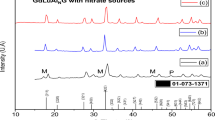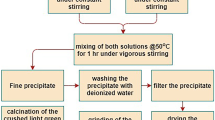Abstract
In the current work, ytterbium oxide (Yb2O3) powders with the europium (Eu3+) were synthesized by the epoxide-driven sol–gel process. Yb2O3-europium xerogels were synthesized at different molar ratios (0, 2, 5, 8, 10, 20, 30, 40, and 50 mol%) and heat-treated at 1273 K in order to yield a dense crystalline material. The powders were characterized by x-ray diffraction (XRD), scanning electron microscopy (SEM), and photoluminescent studies were performed to establish the relationship between their structural and luminescent properties. After a 1273 K heat treatment, the resultant powders consisted of spherical particles and presented different phases with well-defined reflections characteristic of a cubic-type crystalline structure, with crystallite sizes ranging from 14 to 30 nm. Finally, according to the luminescence studies, emission bands between 550 and 700 nm, due to the 5D0 → 7F2 transition level of the europium ion, were searched using wavelengths of 612 and 364 nm for excitation and emission, respectively.



Similar content being viewed by others
References
Unal, F., Kazmanli, K.: Production and Characterization of Re3+:Yb2O3 Nanoparticles. Mater. Sci. Forum. 1034, 117–122 (2021). https://doi.org/10.4028/www.scientific.net/MSF.1034.117
Bünzli, J.G.: Lanthanide photonics: Shaping the nanoworld. Trends. Chem. 1(8), 751–762 (2019). https://doi.org/10.1016/j.trechm.2019.05.0.12
Balaram, V.: Rare earth elements: A review of applications, occurrence, exploration, analysis, recycling, and environmental impact. Geosci. Front. 10(4), 1285–1303 (2019). https://doi.org/10.1016/j.gsf.2018.12.005
Nunes, D., et al.: Tailoring upconversion and morphology of Yb/Eu doped Y2O3 nanostructures by acid composition mediation. Nanomaterials 9(2), 1–17 (2019). https://doi.org/10.3390/nano9020234
Xu, J., et al.: Recent advances in near-infrared emitting lanthanide-doped nanoconstructs: Mechanism, design and application for bioimaging. Coord. Chem. Rev. 381, 104–134 (2019). https://doi.org/10.1016/j.ccr.2018.11.014
Ning, Y., Zhu, M., Zhang, J.L.: Near-infrared (NIR) lanthanide molecular probes for bioimaging and biosensing. Coord. Chem. Rev. 399, 213028 (2019). https://doi.org/10.1016/j.ccr.2019.213028
A. Kumar, N. Yadav, M. Bhatt, N. K. Mishra, P. Chaudhary, R. Singh, Sol-Gel Derived Nanomaterials and It’s Applications: A Review. Res. J. Chem. Sci.5(12), 98–105 (2015). Available: www.isca.me
Schubert, U. and Hüsing, N.: Part One sol – gel chemistry and methods. In: Synthesis of Inorganic Materials, 3rd ed., pp. 1–28. Weinheim: VCH-Wiley Verlag GmbH (2015)
Zhang, Z., Guo, D., Yang, X., Zhang, J.: Calcination of ytterbia aerogels leads to ferromagnetic nanoporous ytterbium oxide networks. Mater. Lett. 261(3), 1–4 (2020). https://doi.org/10.1016/j.matlet.2019.126866
Worsley, M.A., et al.: Chlorine-free, monolithic lanthanide series rare earth oxide aerogels via epoxide-assisted sol-gel method. J. Sol-Gel Sci. Technol. 89(1), 176–188 (2019). https://doi.org/10.1007/s10971-018-4811-y
Sun, L.N., Zhang, H.J., Yu, J.B., Meng, Q.G., Liu, F.Y., Peng, C.Y.: Performance of near-IR luminescent xerogel materials covalently bonded with ternary lanthanide (ErIII, NdIII, YbIII) complexes. J. Photochem. Photobiol. A Chem. 193(2–3), 153–160 (2008). https://doi.org/10.1016/j.jphotochem.2007.06.020
Saravanan, T., et al.: Facile synthesis of Yb2O3-graphene nanocomposites for enhanced energy and environmental applications. Polym. Bull. 77(8), 3891–3906 (2020). https://doi.org/10.1007/s00289-019-02945-2
Bünzli, J.C.G.: Lanthanide light for biology and medical diagnosis. J. Lumin. 170, 866–878 (2016). https://doi.org/10.1016/j.jlumin.2015.07.033
Ma, R., Qian, J., Cui, S., Qiao, X., Wang, F., Fan, X.: Enhancing NIR emission of Yb3+ by silver nanoclusters in oxyfluoride glass. J. Lumin. 152, 222–225 (2014). https://doi.org/10.1016/j.jlumin.2013.10.036
Sohn, Y.: Yb2O3 nanowires, nanorods and nano-square plates. Ceram. Int. 44(3), 3341–3347 (2018). https://doi.org/10.1016/j.ceramint.2017.11.118
Pandey, A.: Sensitization Effect of Yb3+ in Upconversion Luminescence of Eu3+ Codoped Y2O3 Phosphor. J. Phys. Chem. Biophys. 03(05), 1–3 (2013). https://doi.org/10.4172/2161-0398.1000129
Tcibulnikova, A.V., et al.: Cooperative luminescence of Yb3+ ions of the ytterbium oxide porous surface. Opt. Commun. 459, 125006 (2020). https://doi.org/10.1016/j.optcom.2019.125006
Panjonk, G.M., Rao, A.V., Parvathy, R., Elaloui, E.: Microstructural characterization of silica aerogels using scanning electron microscopy. Mater. Sci. 31, 5683–5689 (1996)
Gomes, H. T. et al.: Catalytic properties of carbon materials for wet oxidation of aniline. J. Hazard. Mater. 159(2–3), 420–426 (2008)https://doi.org/10.1016/j.jhazmat.2008.02.070
Xiao, Y., Han, G., Chang, Y.: Electrospun ytterbium and europium ions co-doped stannic oxide nanofibers and application in dye-sensitized solar cells. Mater. Res. Bull. 92, 90–98 (2017). https://doi.org/10.1016/j.materresbull.2017.04.017
Binnemans, K.: Interpretation of europium(III) spectra. Coord. Chem. Rev. 295, 1–45 (2015). https://doi.org/10.1016/j.ccr.2015.02.015
S.E. Braslavsky, Glossary of terms used in photochemistry 3rd Edition (IUPAC Recommendations 2006). Pure Appl. Chem. 79(3), 293–465 (2007). https://doi.org/10.1351/pac200779030293
Acknowledgements
The authors gratefully acknowledge the financial support of this work by Conacyt project A1-S-28234 and by the Instituto Politécnico Nacional through SIP-IPN projects 20231213, 20231223. The authors thanks CNMN-IPN and Lab CREA for experimental support. Alan D. Alcantar Mendoza acknowledges the Conacyt Ms S scholarship. The authors also would like to thank Henry Jankiewicz for the editing work that he did for this paper and M. García Murillo for her assistance.
Author information
Authors and Affiliations
Corresponding author
Ethics declarations
Competing interests
The authors declare that they have no known competing financial interests or personal relationships that could have appeared to influence the work reported in this paper.
The authors declare the following financial interests/personal relationships which may be considered as potential competing interests.
Additional information
Publisher's note
Springer Nature remains neutral with regard to jurisdictional claims in published maps and institutional affiliations.
Rights and permissions
Springer Nature or its licensor (e.g. a society or other partner) holds exclusive rights to this article under a publishing agreement with the author(s) or other rightsholder(s); author self-archiving of the accepted manuscript version of this article is solely governed by the terms of such publishing agreement and applicable law.
About this article
Cite this article
Carrillo Romo, F., Alcantar Mendoza, A., García Murillo, A. et al. Synthesis of ytterbium oxide powders with europium. J Aust Ceram Soc 59, 763–768 (2023). https://doi.org/10.1007/s41779-023-00872-0
Received:
Revised:
Accepted:
Published:
Issue Date:
DOI: https://doi.org/10.1007/s41779-023-00872-0




